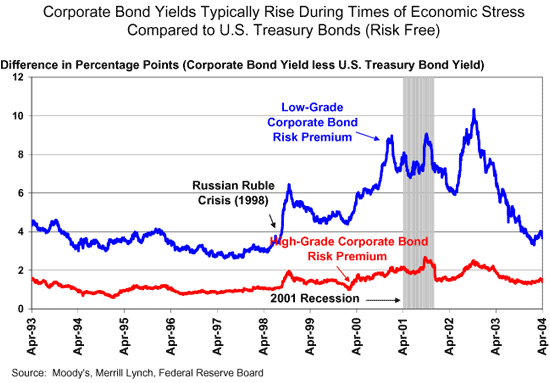Financial markets respond to risk by increasing or decreasing interest rate yields. In the discussion below, we examine differences between yields on Treasury securities and corporate securities to see how risk levels and yields change over time.
Bond Basics
Let’s begin with a quick overview of bonds. The simplest way to think of a bond is to consider it a loan. When investing in a corporate bond, for instance, the investor loans funds to the corporation issuing the bond. In exchange for this loan, the corporation promises to pay the holder of the bond a fixed amount of money at the specified maturity date as well as periodic interest payments until the maturity date. However, the interest rates that bonds earn vary depending on a number of factors, including risk of the investment.
The risk level of a bond, otherwise known as default risk, is one of the most important components that determine a bond’s interest rate.1 Companies such as Moody’s and Standard & Poor’s provide information on a bond’s risk level by gauging the probability that a company will default on its bond obligations. Bonds are then given a rating that ranges from AAA (highest quality bonds with the lowest probability of default) to “junk bonds” (typically speculative with a higher probability of default). Generally, the higher the default risk, the greater the interest rate of return on the bond to compensate for more risk.
Corporate Bonds vs. U.S. Treasury Bonds
While corporate bonds all have some level of default risk (no matter how small), U.S. Treasury bonds are used as a benchmark by the market because they have no default risk. Therefore, corporate bonds always earn a higher interest rate than Treasury bonds. This principle can be seen in Chart 1. High-grade corporate bond yields are typically 1 to 2 percent higher than the yield on U.S. Treasuries. In contrast, low-grade bonds typically have a much higher spread over U.S. Treasury yields.
Chart1

What Happens During Times of Economic Stress
During times of increased economic uncertainty and around recessions (represented by the gray bar on Chart 1), the spread between corporate or junk bond yields and the yields on U.S. Treasuries typically rises. Chart 1 illustrates this phenomenon well; bond spreads did indeed rise during the 2001 recession. Recessions typically contribute to higher rates of business failures and defaults, thus leading to bond buyers demanding higher interest rates to compensate for the risk they are taking when investing in a certain bond. The recent corporate governance scandals likely also contributed to the increased spreads between low-grade bonds and U.S. Treasuries. Another spike in risk spreads in 1998, that was most evident for low-grade bonds, coincided with a period of increased uncertainty that occurred as the Russian Ruble crisis unfolded.
Endnotes
1. In addition to default risk, bond investors also consider interest rate risk which results from the possibility that interest rates will change significantly and thus change the bond price. However, in this discussion, we will focus on differences in default risk and assume that the two securities that we are comparing have similar maturities.
References
Chiodo, Abbigail J, and Michael T. Owyang. (2002) “A case study of a currency crisis: the Russian default of 1998.” Federal Reserve Bank of St. Louis, Review, .84, no. 6. Nov. 2002, pp. 7-18. http://research.stlouisfed.org/publications/review/02/11/ChiodoOwyang.pdf
Moody’s Investors Service Available at: http://www.moodys.com/cust/default.asp
Standard & Poor’s. Available at:
http://www2.standardandpoors.com/NASApp/cs/ContentServer?pagename=sp/Page/HomePg